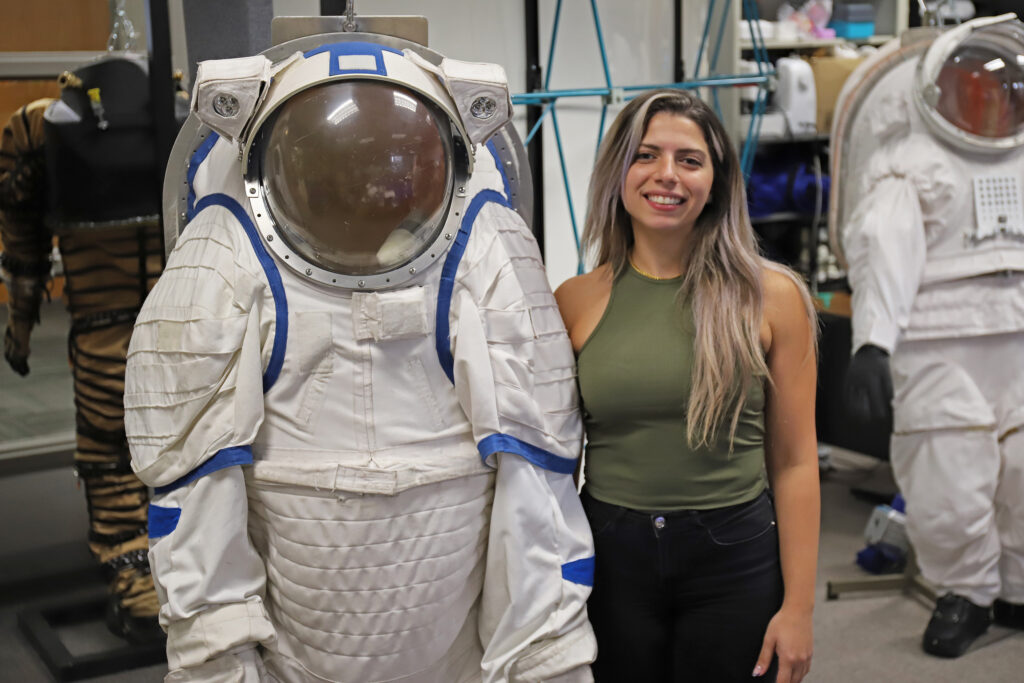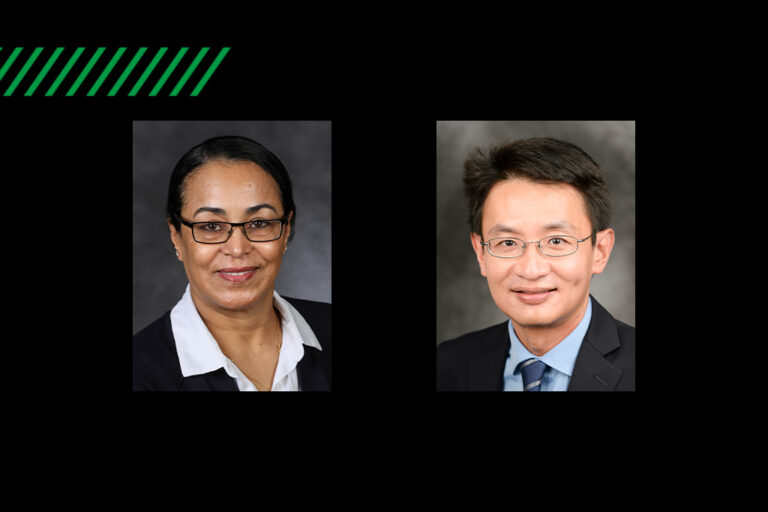Where no Egyptian has gone before
Sara Sabry, the first Egyptian to reach space, is pursuing a doctorate in Aerospace Sciences at UND

If UND students share stories of what they did over the summer, Sara Sabry’s tale likely will top them all: She went into space.
Being the first Egyptian woman to visit space — the first Egyptian person to reach space, period — means a full schedule of appearances. Sabry, along with five other people, participated in Blue Origin’s sixth manned spaceflight on Aug. 4, which launched from Texas. The private spaceflight company is owned by business magnate Jeff Bezos.
Sabry attended orientation on Aug. 17 to familiarize herself with the UND campus and the various labs and facets of the doctoral program in Aerospace Sciences she will be working to complete. Shortly after orientation, she set off for Florida for training with the International Institute of Astronautical Sciences. After a circuitous trip across portions of the U.S. and Europe, she’ll return to her studies.
“I have a lot of travel coming up,” she said, sitting among the spacesuits kept in the Human Spaceflight Laboratory in Clifford Hall, though terrestrial travel certainly can’t compare to extraterrestrial.
And “a lot of travel” is something of an understatement. At the IIAS in Florida, Sabry underwent training designed to prepare astronauts to do research in space. She also underwent training on how to deal with hypoxia – a lack of oxygen – and training to experience high-gravitational forces, the latter of which she said would have come in handy for her own spaceflight.
“I wish I had done the high-G force training before my actual spaceflight, because I did experience very high G’s,” she told UND Today.
After Florida, Sabry will go to Jordan, where she will speak with children interested in the space field. From there, she will attend the International Astronautical Congress in Paris before returning to Egypt for another conference and a series of media interviews about her recent spaceflight. Before returning to UND, she probably will spend a little time in Berlin, where she previously lived and worked.
The road to UND
Designing and evaluating a spacesuit is an interdisciplinary activity that involves experts in the fields of Space Studies, Biomechanics, Kinesiology and others. Sabry, who studied mechanical engineering before earning a master’s degree in biomedical/medical engineering, said she was drawn to UND by the collaborative nature of the Department of Space Studies in the John D. Odegard School of Aerospace Sciences.
Working in that collaborative environment, she said, will allow her to draw on her educational background. Spacesuit design and functionality blends her interests in medical and mechanical engineering.
“I was really interested in how systems touch the health of astronauts, and spacesuits do just that – they keep you alive in space, and they allow you to perform the tasks that you need to do,” she said.
At UND, Sabry will work with Space Studies Professor Pablo de León, who has an extensive history of spacesuit design and testing. De León said Sabry’s unique experience with spaceflight will be a valuable addition to UND Space Studies. Her addition to the program speaks to the quality of education and research going on at the University.
“We have been attracting the best students from all over the world and, the fact that Sara selected UND to do her Ph.D. is clear proof of that,” he said.
De León is a familiar figure for Sabry, as she has followed his research. About a year ago, she founded the nonprofit organization Deep Space Initiative, which seeks to bring about deep space exploration while expanding access to the fields of space science. De León is an advisor to the organization.
Flying to Space
Now a few weeks after her spaceflight, Sabry said she still is trying to process the experience.
She was selected from thousands of candidates to go on the Blue Origin rocket and was sponsored by the nonprofit organization Space for Humanity, an organization that aims to expand access to space and train future leaders.
Sabry loves to describe the “overview effect,” defined by Space for Humanity as “the cognitive shift in awareness that occurs when a human being looks down on the Earth from space.” Sabry, who on Aug. 4 crossed the Kármán line — the threshold between Earth’s atmosphere and outer space some 60 miles above the surface of the planet — said she was overcome with emotion when her feet were finally back on the ground.
“I am passionate about talking about the overview effect, so I can talk about it for hours,” she said. “I have this newfound connection with space, with why we’re trying to explore it. This new reality that I’m living in is like, if I’m going to put it into words, there is no separation between Earth and space, and that we are right there.”
Message of hope
Sabry’s spaceflight has meaning beyond her opened perception. She is using it to instill hope and the benefits of education in Egyptian children. Growing up, she never saw a person in the space field who looked like her, she said. She’s hoping her example can serve as a source of inspiration.
“Education is really important,” she said. “It’s one of the most essential tools to gain control of your life, and to make things happen that people have told you before could never happen.”
-30-

